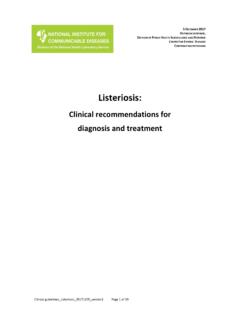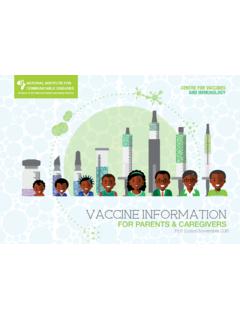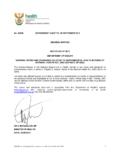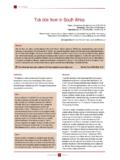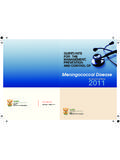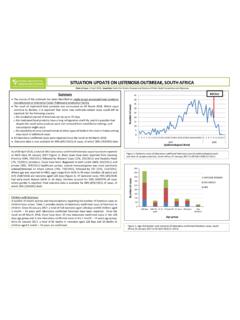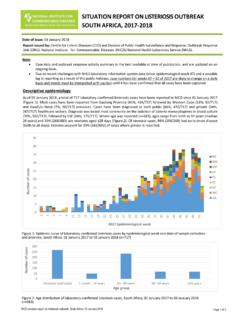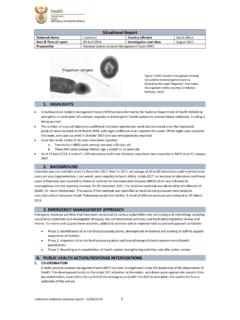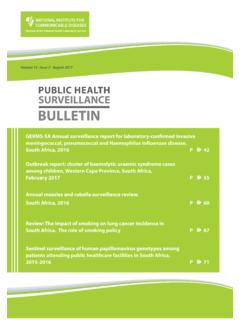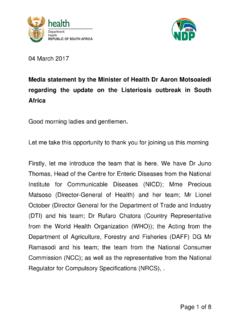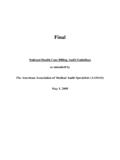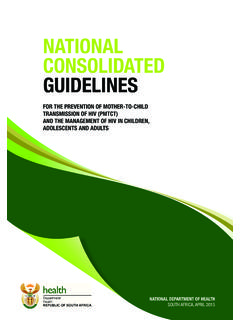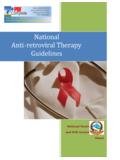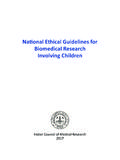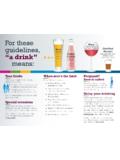Transcription of National Plague Control Guidelines - NICD
1 National Plague Control Guidelines TABLE OF CONTENTS. CONTENTS PAGE. PREFACE 3. ACKNOWLEDGEMENTS 4. 1. EPIDEMIOLOGY OF Plague 5. 2. ETIOLOGY OF Plague . Transmission and Plague pathways 5. 3. HUMAN Plague . Clinical manifestations 8. Bubonic Plague 8. Septicaemic Plague 8. Pneumonic Plague 8. Diagnosis of Plague 9. Case definitions of human Plague 9. Laboratory diagnosis of Plague 9. Management of Plague and prevention of spread 9. Specific antibiotic treatment 9. Treatment in pregnancy and children 10. Supportive therapy 10. Post exposure prophylactic therapy 11. Vaccination 11. Prevention and Control of human Plague transmission 11. Notification 11. Samples 11. Isolation 11. Concurrent disinfection 11. Quarantine 12. Protection of contacts 12. Investigation of contacts and source of infection 12. Education 12. Human surveillance 12. Passive surveillance 12. Community surveillance 13.
2 Active surveillance 13. Plague Control Guidelines for South Africa 1. Standardised reports 13. Core information 13. Clinical observations and treatment 13. Laboratory analyses 14. Additional epidemiological and environmental information 14. Epidemiologic follow-up of pneumonic Plague cases 14. Ecological and environmental observations 14. Outbreak measures 14. General safety precautions 15. Communication networks 15. 4. Plague in Animals Epidemiology of Plague in animals 16. Rodent reservoirs 16. Flea vectors 16. Plague Control in animals 17. Surveillance 17. Rodent surveillance 18. Dogs and carnivore surveillance 18. Flea surveillance 18. Specific Control Measures 18. Control in dogs and cats 18. Rat Control programmes 18. Environmental health 18. 5. Plague legislation 19. 6. MONITORING AND EVALUATION 19. Data management 19. Indicators 19. 7. REFERENCES 20. 8. GLOSSARY 21.
3 Annexure 1: Notified Plague cases and deaths, 1921 1982 23. Annexure 2: Treatment and prophylaxis Guidelines 24. Annexure 3: Equipment required for collection of dog/rodent speciments 27. Annexure 4: Pesticides registered for use in South Africa 28. Annexure 5: Contact details and useful sources of information 29. 2 Plague Control Guidelines for South Africa PREFACE. It gives me great pleasure to introduce The Plague Control Guidelines . Human cases of Plague have been notifiable in South Africa since 1919 with the first recorded case going as far back as 1899. The last reported case was in 1982 in Coega, Eastern Cape. However, countries surrounding South Africa continue to report human Plague . Thus, it is extremely important that South Africa remains vigilant and establishes Plague surveillance in high-risk areas. The aim of this document is to provide a source of reference to the persons involved in the Control of Plague in South Africa.
4 The outcome aimed for is a uniformed approach to Plague surveillance nationally, appropriate treatment of Plague cases and prompt and efficient outbreak response in the event of a Plague outbreak. These Guidelines are based on the Plague Manual: Epidemiology, distribution, surveillance and Control compiled by the World Health Organisation, findings from research conducted in South Africa and experience gained from Plague surveillance programmes in the country. The development of these Guidelines was initiated by the National Department of Health and they were compiled in collaboration with the National Plague Working Group and other experts in the field. Three different aspects of Plague are dealt with in the document. The first section deals with the epidemiological aspects of Plague , while the second section is concerned with the clinical side of Plague and the last is more for personnel involved in prevention and Control of Plague .
5 It is hoped these Guidelines will be used by all role players to provide effective Plague Control and management in South Africa. Dr ME Tshabalala-Msimang Minister of Health Plague Control Guidelines for South Africa 3. ACKNOWLEDGEMENTS. The Plague Control Guidelines were developed by the National Department of Health in collaboration with the Plague Working Group. The group was established to facilitate the development of these Guidelines and comprised of members from the provincial Department of Health, South African Local Government Association (SALGA), Agricultural Research Council (ARC), National Institute For Communicable Diseases (NICD), National Health Laboratory Service (NHLS), World Wildlife Fund (WWF), University of Witwatersrand, University of Pretoria, and Port Elizabeth Technikon (Now Nelson Mandela Metropolitan University of Technology (NMMUT)). These Guidelines were compiled using available information.
6 Without the contributions of the persons mentioned below these Guidelines would not have been a reality. I would therefore like to express my sincere gratitude to: Dr MRB Maloba, National Department of Health (NDoH); Mr T Ledwaba, NDoH; Mr D Moonasar, NDoH; Ms C Johnson, NDoH;. Mrs N Willers, NDoH; Ms L Artzen NICD, NHLS; Mr A Booman, Mpumalanga, Department of Health (DoH); Mr Du Plessis, Northern Cape DoH; Prof J Frean, NICD; Mr M Greling, North West DoH; Mr O Jacobs, Gauteng Port Health; Mr A Jagarnath, KwaZulu Natal Port Health; Mr F Kirsten, ARC;. Ms P Leman, NICD; Dr H Maarschalk, PE Technikon (NMMUT); Mr A Marumo, Gauteng DoH; Dr S Meyer, National Department of Agriculture, Animal Health; Ms D Mhlophe, Environmental Health, NDoH; Mr Robin Sauvage, Pest Control ; Mr M Slabert, Western Cape Port Health; Mr C. Terblanche, Free State DoH; Mr A van Olm, Eastern Cape Port Health; Mr J van Zyl, SALGA; Mr F Venturi, Kirstenbosch Research Institute; Mr Z.
7 Zincume, NDoH; Mr J van Niekerk, City of Johannesburg, DoH; Mr Z Zwane, Mpumalanga DoH; Mr C Bezuidenhout, Gauteng DoH; Prof N Pillay, University of Witwatersrand; Dr G Booker, Onderstepoort Veterinary Institute; Mr A Wild, Eastern Cape PHC; Mrs S Naidoo, KwaZulu Natal Port Health; Ms S Raleru, Airports Company of South Africa; Mr W Dunywa, Eastern Cape DoH and Mr S Msimang, Kwazulu Natal. Mr T Mseleku Director-General: Department of Health 4 Plague Control Guidelines for South Africa 1. EPIDEMIOLOGY OF Plague . Plague is an acute bacterial infection caused by Yersinia pestis, which mainly affects rodents. Wild Plague exists independent of human populations and their activities in natural foci of the disease in wild rodent colonies. These natural foci require constant surveillance, since Plague has a high potential for spread into susceptible areas. Conditions in each natural focus may be expected to vary and require monitoring to determine the extent and characteristics of the disease in a given area.
8 Such studies define the importance and magnitude of the Plague problem in particular foci and provide baseline data for surveillance and integrated Control programmes. Transmission between rodents is by their flea ectoparasites. Domestic Plague is closely associated with rodents living with humans and can cause epidemics in both human and animal populations. Transmission from rodents to humans is by their flea ectoparasites under appropriate conditions. The ecology of Plague is highly variable as there is a complex interaction between the hosts, vectors and the Plague bacilli that is influenced by factors such as host susceptibility, season, temperature, humidity, and availability of food and the transmission efficiency of fleas. The World Health Organization in 2003 reported 2 651 Plague cases and 175 deaths globally. Of these reports, 80% were from 12 countries in Africa and the countries in southern Africa included Namibia, Angola, the DRC, Malawi, Tanzania, Mozambique, Zimbabwe and Madagascar.
9 Plague was first introduced to South Africa through its harbours during the third pandemic, which began its worldwide spread from Hong Kong in 1894. The disease spread inland with several outbreaks occurring, following which it spread to wild rodents in remote areas. These wild rodents are at present the most important potential sources of Plague . Between 1899 and 1926, 2 568 cases with 1505 deaths were collected by the South African Institute for Medical Research; formal notifications began in 1921 (see Apnnexure 1). Although the incidence of Plague decreased from the 1950s it remains a threat, since susceptible wild rodent foci exist in several parts of South Africa, namely Eastern Cape, Northern Cape, Free State, Mpumalanga and Gauteng Provinces. In South Africa the last reported outbreak of Plague occurred in Coega, Eastern Cape in 1982, with 13 cases and 1 death. Many years may lapse between the occurrences of isolated cases or epidemics; therefore continuous surveillance of rodents and their vector populations are important even during periods when no human cases are reported.
10 Plague is subject to the International Health Regulations and every case must be notified to the World Health Organization and the health authorities of a country. 2. ETIOLOGY OF Plague . Transmission and Plague pathways Transmission of Plague from animal to humans is usually via the bite of an infected flea (Figure 1). When a flea feeds, blood is taken into the stomach. If Plague bacilli are present in the blood meal they are taken into the flea's midgut, multiply and form an obstruction at the flea's proventriculus. As the flea repeatedly attempts to feed, the ingested blood prevented from reaching its stomach due to this obstruction, mixes with the Plague bacilli and is regurgitated into the wound. The time until infectivity of a flea that has ingested Plague bacilli varies with their species and external temperature and humidity, as does the survival time of fleas, which is also influenced by whether or not they are fed.
